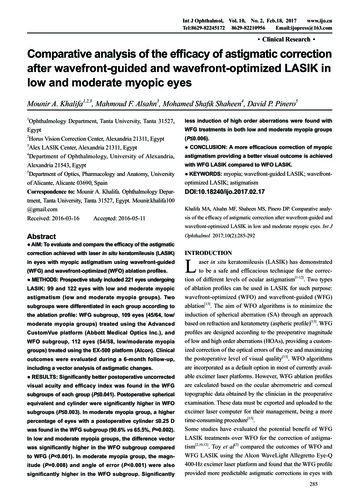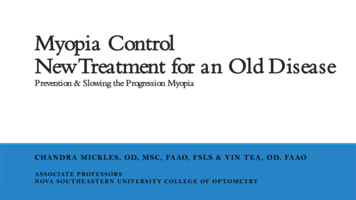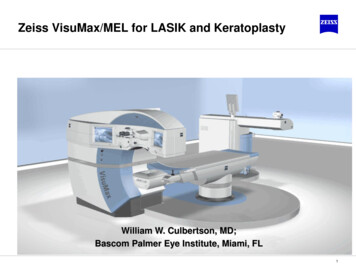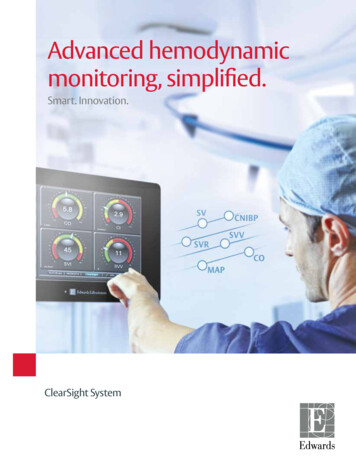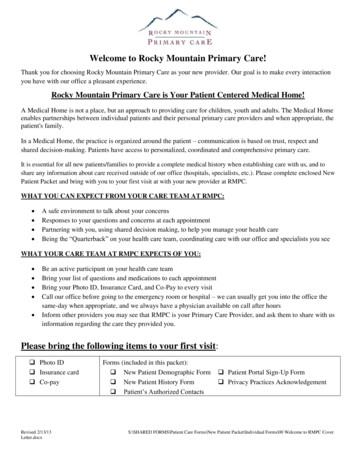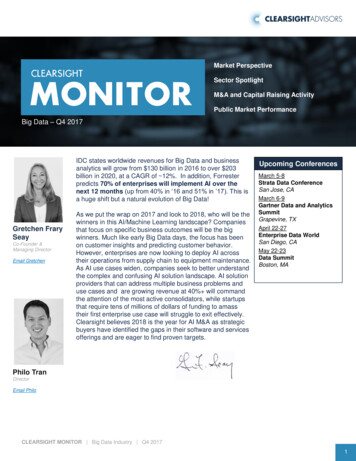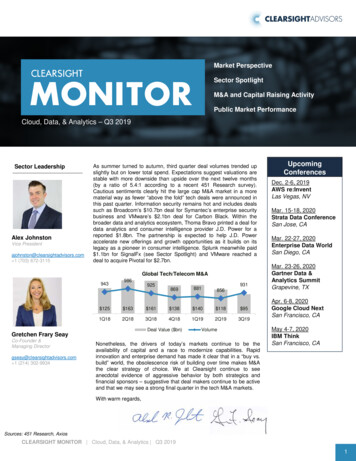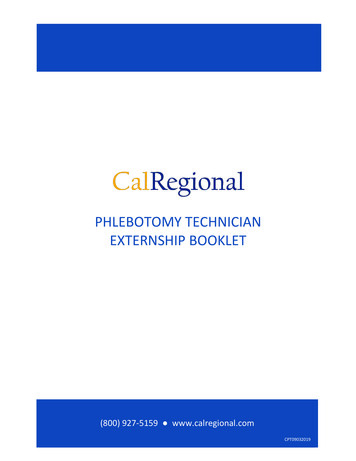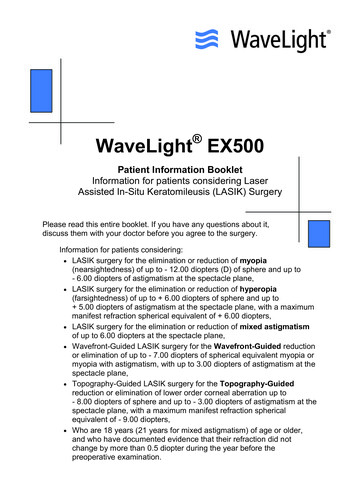
Transcription
WaveLight EX500Patient Information BookletInformation for patients considering LaserAssisted In-Situ Keratomileusis (LASIK) SurgeryPlease read this entire booklet. If you have any questions about it,discuss them with your doctor before you agree to the surgery.Information for patients considering: LASIK surgery for the elimination or reduction of myopia(nearsightedness) of up to - 12.00 diopters (D) of sphere and up to- 6.00 diopters of astigmatism at the spectacle plane, LASIK surgery for the elimination or reduction of hyperopia(farsightedness) of up to 6.00 diopters of sphere and up to 5.00 diopters of astigmatism at the spectacle plane, with a maximummanifest refraction spherical equivalent of 6.00 diopters, LASIK surgery for the elimination or reduction of mixed astigmatismof up to 6.00 diopters at the spectacle plane, Wavefront-Guided LASIK surgery for the Wavefront-Guided reductionor elimination of up to - 7.00 diopters of spherical equivalent myopia ormyopia with astigmatism, with up to 3.00 diopters of astigmatism at thespectacle plane, Topography-Guided LASIK surgery for the Topography-Guidedreduction or elimination of lower order corneal aberration up to- 8.00 diopters of sphere and up to - 3.00 diopters of astigmatism at thespectacle plane, with a maximum manifest refraction sphericalequivalent of - 9.00 diopters, Who are 18 years (21 years for mixed astigmatism) of age or older,and who have documented evidence that their refraction did notchange by more than 0.5 diopter during the year before thepreoperative examination.
This documentation is copyrighted with all rights reserved. Under copyright laws this documentation may notbe reproduced or transmitted in whole or in part in any form or by any means, electronic or mechanical,including photocopying, recording, or any information storage and retrieval system, without permission inwriting from WaveLight GmbH.Permitted copies must carry the same proprietary and copyright notices as were affixed to the original.Under the law, copying includes also translation into other languages.Please note that while every effort has been made to ensure that the data given in this documentation areaccurate, the information, figures, illustration, tables, specifications and schematics contained herein aresubject to change without notice.All images are representative. The numbers shown in the images are just examples and may not representtypical values. Some sections of this documentation may not apply for all devices. Such sections will bemarked accordingly. Other documentations may apply as well for use of the device described herein. WaveLight is a registered trademark of WaveLight GmbH. WaveLight FS200 and WaveLight EX500 are registered trademarks of WaveLight GmbH. WaveLight Refractive Suite is a registered trademark of WaveLight GmbH. ALLEGRETTO WAVE EYE-Q is a registered trademark of WaveLight GmbH.WaveNet is a registered trademark of WaveLight GmbH.WaveNet Planning Software is a registered trademark of WaveLight GmbH.WaveNet Server is a registered trademark of WaveLight GmbH. WaveLight Analyzer II is a registered trademark of WaveLight GmbH. WaveLight Oculyzer II is a registered trademark of WaveLight GmbH. WaveLight OB820 is a registered trademark of WaveLight GmbH.Wavefront Optimized is a registered trademark of WaveLight GmbH. Custom Q is a registered trademark of WaveLight GmbH. PerfectPulse Technology is a registered trademark of WaveLight GmbH. Right.From the Start. is a registered trademark of WaveLight GmbH. Accutane is a registered trademark of Hoffmann-La Roche Inc. Cordarone is a registered trademark of Wyeth Inc. Imitrex is a registered trademark of GlaxoSmithKline Inc.Zeiss and OPMI are registered trademarks of Carl Zeiss.Microsoft, Windows is a registered trademark of Microsoft Corporation.7-Zip is under the GNU LGPL license, http://7-zip.org/download.html (please refer to the User Manual) Copyright by WaveLight GmbH, GermanyAll Rights reservedPage 2 of 88WaveLight EX500 1016-3 Patient Booklet us / Rev.3 / 15-06-17 Item No.: 6675 2003
ContentsCONTENTSPage1.GLOSSARY .42.INTRODUCTION . 103.COMMON VISION PROBLEMS . 114.WHAT IS THE WAVELIGHT EX500 LASER SYSTEM? . 165.WHAT IS WAVEFRONT-GUIDED LASIK? . 186.WHAT IS THE WAVELIGHT ANALYZER? . 207.WHAT IS TOPOGRAPHY-GUIDED LASIK?. 218.WHAT IS THE WAVELIGHT TOPOLYZER? . 239.HOW DOES LASIK CORRECT . 2410. CONTRAINDICATIONS, WARNINGS AND PRECAUTIONS . 2811. WHAT ARE ITS BENEFITS? . 3312. WHAT ARE ITS RISKS? . 4513. WHAT WILL HAPPEN BEFORE, DURING AND AFTER LASIK? . 6914. FREQUENTLY ASKED QUESTIONS . 7415. WHAT SHOULD YOU ASK YOUR DOCTOR? . 8116. SUMMARY OF IMPORTANT INFORMATION . 8217. SELF TEST . 8318. WHERE CAN YOU GET MORE INFORMATION? . 8419. ANSWERS TO SELF-TEST QUESTIONS . 8520. INDEX . 86WaveLight EX500 1016-3 Patient Booklet us / Rev.3 / 15-06-17 Item No.: 6675 2003Page 3 of 88
Glossary1.GLOSSARYAberrometerWavefront AnalyzerAblation, AblateRemoval of tissue with an excimer laser.Ametropic EyeAn eye abnormality, such as nearsightedness,farsightedness, or astigmatism, resulting from faultyrefractive ability of the eye.Analgesic MedicationPain relieving medication.Anesthetic Eye DropsMedication used to numb the eye.Antibiotic Eye DropsMedication used to prevent or treat infections of the eye.Anti-inflammatory EyeDropsMedication used to prevent or treat inflammation of theeye.AstigmatismA type of refractive error occurring when the cornea orlens is flatter or steeper in one direction than it is in theother direction (much like the shape of a football),resulting in images that are focused at two differentdistances from the retina. The amount of astigmatism ismeasured in diopters.Autoimmune DiseaseCondition in which the body attacks itself that may lead toinflammation or swelling of parts of the body. An exampleis multiple sclerosis.Bandage Contact LensSoft contact lens temporarily used to cover the corneaafter surgery.Best Corrected VisualAcuityThe best vision that can be obtained with glasses.BSCVAAbbreviation of Best spectacle corrected visual acuity.Best visual acuity with glasses.CataractClouding of the lens inside the eye that may cause loss ofvision.Cataract SurgerySurgical removal of the opaque lens and replacement withartificial lens (“IOL”).Clear Lens ExchangeRefractive surgery similar to cataract surgery where theclear lens of the eye is removed.Page 4 of 88WaveLight EX500 1016-3 Patient Booklet us / Rev.3 / 15-06-17 Item No.: 6675 2003
GlossaryCollagen VascularDiseaseCondition that alters the way the body creates ormetabolizes connective tissue, like collagen. The corneais made up of collagen. Examples are lupus orrheumatoid arthritis.CorneaThe clear front surface of the eye, which bends rays oflight to focus an image of objects on the retina.Corneal Epithelium /TissueSurface cells, forming the top layer of the cornea.Corneal EpithelialDefectDamage in the top layer of the cornea that may result inpain or discomfort. The damage is temporary and usuallyheals quickly.Custom or CustomizedSurgeryRefractive surgery that is based on more information thanjust the amount of nearsightedness, farsightedness andastigmatism.CylinderValue that describes the amount of astigmatism.Diffuse LamellarKeratitisInflammation under the flap.DiopterUnit used to measure the amount of nearsightedness,farsightedness and astigmatism. Nearsightedness ismeasured in terms of negative diopters. Farsightedness ismeasured in terms of positive diopters. Astigmatism canbe measured in either positive or negative diopters.Epithelial IngrowthA condition in which cells from the surface of the cornea(the corneal epithelium) start growing underneath thecorneal flap that's produced in the LASIK procedure.Excimer LaserA type of laser emitting UV light that is used in PRK orLASIK to remove corneal tissue precisely and withoutdamage to surrounding tissue.EyetrackerDevice that detects and tracks the position of the eye orpupil. Such a tracker may enable laser systems to followmovements of the eye with the laser beam.Farsightedness(Hyperopia)A type of refractive error in which the cornea is too flatand/or the eye is too short, resulting in images that arefocused behind the retina. Near objects seem blurry,distant objects may be seen more clearly than nearobjects, although objects in the distance may also beblurry.WaveLight EX500 1016-3 Patient Booklet us / Rev.3 / 15-06-17 Item No.: 6675 2003Page 5 of 88
GlossaryFDAFood and Drug Administration. This is the governmentalagency that approves medical technology for use in theU.S.A.Femtosecond LaserInfrared laser that can divide corneal tissue without heator impact to the surrounding cornea. This can be used tocreate a corneal flap for LASIK.FlapThin slice of corneal tissue created on the surface of thecornea with a microkeratome or femtosecond laser aspart of the LASIK procedure.FloatersCloudy structures in the fluid in the center of the eyeballcausing “floating” structures in the image.GlaucomaA group of diseases that cause increased pressure in theeye and can result in vision loss by damaging the opticnerve.HaloCircular flares of light around bright lights in dim lightingconditions.HazeCloudiness of the cornea.Herpes SimplexA virus that can cause cold sores and eye infections.Herpes ZosterA virus that can cause an infection with blisters on oneside of the body.HyperopiaMedical term for farsightedness.ImmunodeficiencyDiseaseA condition that alters the body’s ability to fight infection.An example is AIDS.IOLArtificial lens used to replace the natural lens of the eye.IrisThe colored part of the eye, between the cornea and thelens that controls the amount of light reaching the retinaby changing the size of the pupil.InterfaceInterface layer between the flap and the remainingcorneal tissue.KeratoconusCondition of the cornea that results in progressivethinning and steepening of the cornea with a reduction invisual acuity.KeratomileusisSculpting of the cornea by removing tissue.KeratotomyCutting the cornea.Page 6 of 88WaveLight EX500 1016-3 Patient Booklet us / Rev.3 / 15-06-17 Item No.: 6675 2003
GlossaryLamellar KeratitisInflammation under the flap.Laser In-situKeratomileusis (LASIK)Refractive surgery that changes corneal curvature byremoving corneal tissue beneath a flap.Laser MicrokeratomePrecision laser instrument used to create a flap duringLASIK surgery. Also referred to as femtosecond laser.LASIKAcronym for laser in-situ keratomileusis.LensA clear structure behind the iris that helps focus rays oflight, or an image, on the retina.MechanicalMicrokeratomeA precision instrument that is used to create the flapduring LASIK surgery.Micron1/1000 of a millimeter or 4/10000 inch. The symbol is”µm”.Mixed AstigmatismA type of astigmatism in which the cornea is too flat in onedirection and too steep in the other direction, resulting inblurred vision, double images, or ghost images fromimages that are focused both in front of the retina andbehind the retina.MyopiaMedical term for nearsightedness.Nearsightedness(Myopia)A type of refractive error in which the cornea is too steepand/or the eye is too long, resulting in images that arefocused in front of the retina. Distant objects are blurry butnear objects are clear. The amount of nearsightedness ismeasured in diopters.Optic NerveA bundle of more than 1 million nerve fibers in the back ofthe eye that carry visual messages from the retina to thebrain.OpticalOf or pertaining to sight; applying optics or the principlesof optics to assist sight or correct vision. Optics is thebranch of science that deals with light and vision.Optical PowerAbility of an object such as the eye to bend light rays asthey pass through.Optical ZonePart of the treatment area in which the refractive lasertreatment shall be effective.PhotorefractiveKeratectomy (PRK)Refractive surgery that changes corneal curvature byremoving corneal tissue after the top layer of cells(corneal epithelium) is removed without making a flap.WaveLight EX500 1016-3 Patient Booklet us / Rev.3 / 15-06-17 Item No.: 6675 2003Page 7 of 88
GlossaryPresbyopiaA condition where, with age, the lens loses its ability tochange shape and the eye exhibits a progressivelydiminished ability to focus on near objects.PRKAcronym for photorefractive keratectomy.Placido ImagingPlacido Topography is the classical form of mapping thesurface of the cornea.PtosisDrooping of the upper eye lid.PupilThe opening in the center of the iris. The iris changes thesize of the pupil and controls how much light enters theeye.Radial Keratotomy (RK)Refractive surgery that changes corneal curvature byusing a knife to make pie-shaped cuts in the cornea.Refractive ErrorA condition of the eye that occurs when light does notfocus perfectly on the retina and distant images becomeblurry.Refractive SurgeryEye surgery that aims to change the shape of the corneapermanently to correct refractive errors. This change ineye shape restores the focusing power of the eye byallowing the light rays to focus precisely on the retina forimproved vision.RetinaThe light-sensitive and color-sensitive membrane insidethe eye that transforms light images into nerve signals.RKAcronym for radial keratotomy.Standard LASIKWavefront Optimized LASIK refractive surgery that usesonly the amount of nearsightedness, farsightedness,and/or astigmatism (refractive error) to calculate theLASIK treatment plan.SteroidsMedications used to reduce inflammation or the body’shealing response after injury or disease.StriaeMinute grove/lines of a parallel series on the cornea.Suction RingThe part of the microkeratome that attaches it to the eyeand holds the eye in position as the corneal flap is made.TopographyA method of computer-assisted examination of thecornea. It creates a detailed map of the cornea and anyvariations in the smoothness of the cornea.Topography-GuidedLASIKLASIK treatment based on topographic acquired data.Page 8 of 88WaveLight EX500 1016-3 Patient Booklet us / Rev.3 / 15-06-17 Item No.: 6675 2003
GlossaryTopographic systemDevice designed to analyze optical errors by means oftopographic data.Treatment ZoneArea on the cornea where tissue is removed during lasertreatment.Traditional LASIKWavefront Optimized LASIK refractive surgery that usesonly the amount of nearsightedness, farsightedness,and/or astigmatism (refractive error) to calculate theLASIK treatment plan.Vitreous, Vitreous bodyGel-like fluid that fills the inside of the eye.WavefrontImage of light waves. Can be used to determine errors ofan eye.Wavefront-GuidedLASIKLASIK treatment based on wavefront acquired data.Wavefront AnalyzerDevice designed to analyze optical errors by means ofwavefront data.Wavefront OptimizedLASIKThe trade name for LASIK that is performed with theWaveLight EX500 excimer laser system. This procedureuses the amount of nearsightedness, farsightednessand/or astigmatism and some corneal shape informationto calculate the LASIK treatment plan.WaveLight Analyzer IITrade name for a modern wavefront analyzing device,manufactured by WaveLight GmbH in Germany.WaveLight EX500Laser SystemTrade name for modern high speed excimer laser systemwith eyetracker for treatment of refractive errors,manufactured by WaveLight GmbH in Germany.ALLEGRO Topolyzer /ALLEGRO TopolyzerVARIODevice for analyzing topographic errors in human eyes.Table 1: GlossaryWaveLight EX500 1016-3 Patient Booklet us / Rev.3 / 15-06-17 Item No.: 6675 2003Page 9 of 88
Introduction2.INTRODUCTIONThis booklet has important information about LASIK, Wavefront-Guided LASIK andTopography-Guided LASIK surgery with the WaveLight EX500 laser system.Please read this entire booklet before you decide to have this surgery. Your doctor canhelp you decide if a LASIK treatment is suitable for you. Make sure your doctor answersall your questions to your satisfaction before you agree to have a LASIK treatment. Allterms printed in bold can be found in the glossary at the end of the booklet. The glossarydefines each of these terms for you.Discuss the content of this booklet and any questions you may have with your doctor.Your doctor can help you decide if a LASIK, Wavefront-Guided LASIK or aTopography-Guided LASIK treatment is right for you. Contraindications, warnings andprecautions of the procedure are listed in this booklet. Check with your doctor possiblecontraindications, precautions and warnings that may apply to you. Make sure yourdoctor answers all your questions to your satisfaction before you agree to have LASIK,Wavefront-Guided LASIK or Topography-Guided LASIK treatment.Some occupations may have certain vision requirements that cannot be met with arefractive surgical procedure. Please check details before making the decision to havesurgery.Page 10 of 88WaveLight EX500 1016-3 Patient Booklet us / Rev.3 / 15-06-17 Item No.: 6675 2003
Common Vision Problems3.COMMON VISION PROBLEMSThe human eye (see figure 1 below) is very much like a camera (see figure 2 below).The camera lens focuses light to form clear images onto film. Similarly, the cornea andlens of the eye focus light onto the back surface of the eye, called the retina.Figure 1: The Human EyeFigure 2: CameraHowever, in some people this focusing of light does not occur perfectly. Peopleencounter three types of refractive errors that can occur:nearsightedness, farsightedness and astigmatism. Some eyes with astigmatism errorshow a special type of this error, called mixed astigmatism.In all types, the eye is not able to focus images perfectly on the retina.WaveLight EX500 1016-3 Patient Booklet us / Rev.3 / 15-06-17 Item No.: 6675 2003Page 11 of 88
Common Vision ProblemsNearsightedness (Myopia) is a type of focusing error that results in blurry distant vision.Light from a distant object focuses in front of the retina, rather than on the retina. Imagesof distant objects appear blurry on retina.Figure 3 shows that distant vision is blurry when light focuses incorrectly in nearsightedeyes.Figure 3: Nearsighted Eye Looking At A Black CrossNearsightedness is not a disease, it is a variation of the human eye that tends to begenetic. It occurs quite frequently all around the world, e.g. 25% of all North Americansare nearsighted. This condition starts developing usually during childhood and stabilizesin the late teens or early adulthood. Reasons for the nearsighted condition are too muchdistance between the lens and retina or too much optical power of the lens and cornea.Page 12 of 88WaveLight EX500 1016-3 Patient Booklet us / Rev.3 / 15-06-17 Item No.: 6675 2003
Common Vision ProblemsFarsightedness (Hyperopia) is a condition of the human eye where people may seedistant objects clear while near objects appear blurry. The image is focused beyond theretina as shown in figure 4 below. The focal point, which is where a sharp imageappears, would be outside the eye. Farsightedness commonly becomes evident later inlife. Eyes of young people are often able to compensate for this condition. As we age,we lose this ability.Figure 4: Farsighted Eye Looking At A Black CrossAstigmatism may occur along with nearsightedness (myopic astigmatism),farsightedness (hyperopic astigmatism), or a combination of nearsightedness andfarsightedness (mixed astigmatism).The astigmatism creates blurry images on theretina. If you look at objects with various edges, some edges may look less blurry thanother edges.Mixed astigmatism is a condition of the human eye where people may see neitherdistant nor near objects clear. The image is focused twice in the eye, partially in frontand partially behind the retina. A single focal point, which is where a sharp imageappears, does not exist with mixed astigmatism.Mixed astigmatism creates blurry images on the retina. If you look at objects with edgesin various directions, some edges may look less blurry than other edges.WaveLight EX500 1016-3 Patient Booklet us / Rev.3 / 15-06-17 Item No.: 6675 2003Page 13 of 88
Common Vision ProblemsThe reason for this condition is that the optical power of the eye differs, depending onthe direction. This leads to different focal points in the eye as shown in the figures below.Light from a distant object is focused twice and not perfectly in each focal point. Theimage on the retina is blurry and distorted.On Retina(To Brain)Figure 5: Nearsighted Eye With Astigmatism Looking At A Black CrossOn Retina(To Brain)Figure 6: Farsighted Eye With Astigmatism Looking At A Black CrossPresbyopia is a common type of vision problem that occurs as you age. As people age,the lens becomes stiff, so its focusing power will no longer change. When this occurs,the lens is no longer able to focus light rays on the retina and the light rays becomefocused behind the retina (similar to farsightedness in figure 6 above). Near objects areblurred, even for eyes with perfect distance vision, and reading glasses may be requiredto see objects that are close.Page 14 of 88WaveLight EX500 1016-3 Patient Booklet us / Rev.3 / 15-06-17 Item No.: 6675 2003
Common Vision ProblemsOn Retina(To Brain)Figure 7: Eye With Mixed Astigmatism Looking At A Black CrossThe magnitude of all these errors is described by a single number of measures calleddiopter.Usually wearing glasses or contact lenses helps your eye focus light properly and on theretina. LASIK surgery is another way to improve this focusing property. It uses anexcimer laser to remove tiny amounts of tissue from the cornea. This type of laser doesnot change any other parts of the eye.WaveLight EX500 1016-3 Patient Booklet us / Rev.3 / 15-06-17 Item No.: 6675 2003Page 15 of 88
What Is The WaveLight EX500 Laser System?4.WHAT IS THE WAVELIGHT EX500 LASER SYSTEM?The WaveLight EX500 laser system (see figure 8 on page 17) consists of the laserconsole, which includes the laser and all control systems necessary for the surgeon toperform LASIK, Wavefront-Guided LASIK or Topography-Guided LASIK, such as controlpanels, monitors and a microscope. The WaveLight EX500 laser system uses a verysmall laser beam to reshape the cornea. The system is equipped with an eyetracker tohelp assure that it places the laser pulses in the correct position on the eye. Theeyetracker will interrupt the treatment if your eye moves too much. The laser beam has aspecially shaped profile and a small spot diameter to achieve the desired contour of thetreated surface. When you are prepared for LASIK, Wavefront-Guided LASIK orTopography-Guided LASIK, you will lie down on a bed. This bed is then moved underthe laser and the LASIK, Wavefront-Guided LASIK or Topography-Guided LASIKtreatment will be started.The WaveLight EX500 laser system is approved for: treating patients who have up to - 12 diopters of nearsightedness with or withoutastigmatism of up to 6.0 diopters, who are 18 years of age or older, and who havedocumented evidence that their refraction did not change by more than 0.5 diopterduring the year before the preoperative examination. treating patients who have up to 6 diopters of farsightedness with or withoutastigmatism of up to 5.0 diopters, with a maximum manifest refraction sphericalequivalent of 6.0 diopters, who are 18 years of age or older, and who havedocumented evidence that their refraction did not change by more than 0.5 diopterduring the year before the preoperative examination. treating patients with mixed astigmatism error who have up to 6 diopters ofastigmatism, who are 21 years of age or older, and who have documented evidencethat their refraction did not change by more than 0.5 diopter during the year beforethe preoperative examination. Wavefront-Guided treatments of patients who have up to - 7.00 diopters ofnearsightedness with or without astigmatism of up to 3.00 diopters, who are18 years of age or older, and who have documented evidence that their refractiondid not change by more than 0.5 diopter during the year before the preoperativeexamination. Topography-Guided treatments of patients who have up to - 8.0 diopters ofnearsightedness with or without astigmatism of up to - 3.0 diopters, with a maximummanifest refraction spherical equivalent of - 9.00 diopters, who are 18 years of ageor older and who have documented evidence that their refraction did not change bymore than 0.5 diopter during the year before the preoperative examination.Page 16 of 88WaveLight EX500 1016-3 Patient Booklet us / Rev.3 / 15-06-17 Item No.: 6675 2003
What Is The WaveLight EX500 Laser System? Figure 8: Example WaveLight EX500 DeviceWaveLight EX500 1016-3 Patient Booklet us / Rev.3 / 15-06-17 Item No.: 6675 2003Page 17 of 88
What is Wavefront-Guided LASIK?5.WHAT IS WAVEFRONT-GUIDED LASIK?Glasses and contact lenses correct the main refractive errors nearsightedness,farsightedness and astigmatism. They help your eye to focus the incoming light properlyon the retina.Besides the three main errors each eye has other imperfections or errors. They areusually smaller in magnitude but more complex. Wavefront technology can analyzesuch errors in addition to nearsightedness, farsightedness and astigmatism.The WaveLight EX500 uses the acquired information for custom surgery. TheWaveLight EX500 will remove tiny amounts of tissue from the cornea. It does notchange any other parts of the eye.Wavefront-Guided LASIK is a highly customized surgery compared to “off the shelf”Wavefront Optimized LASIK, standard LASIK or traditional LASIK.Wavefront Optimized, standard and traditional LASIK are both terms referring to thesame procedure. Wavefront Optimized (“standard” or “traditional”) LASIK is different thanwavefront-Guided LASIK. Wavefront Optimized LASIK does not use individual wavefrontdata.Page 18 of 88WaveLight EX500 1016-3 Patient Booklet us / Rev.3 / 15-06-17 Item No.: 6675 2003
What is Wavefront-Guided LASIK?Wavefront Analysis:Wavefront analysis of an eye is a different way to analyze its errors.Wavefronts may be understood as images of light waves traveling through an eye.Wavefronts can be used to determine the errors of an eye.Wavefront detecting devices are called wavefront analyzers or aberrometers. Suchdevices are able to provide highly detailed information for a custom Wavefront-GuidedLASIK treatment.Wavefront data will provide maps of the wavefront error. Such wavefront error mapsinclude simple errors like nearsightedness and astigmatism as well as the more complexindividual errors. In typical eyes nearsightedness, farsightedness and astigmatism areusually much more than the complex individual errors.No Nearsightedness,and No Complex ErrorsNearsightedness withSmaller Complex ErrorsNearsightedness withHigher Complex ErrorsFigure 9: Examples For Wavefront Error Maps Without Nearsightedness And No Complex ErrorsAn ideal eye has no wavefront error, the wavefront map would be flat (see figure 9“Examples For Wavefront Error Maps Without Nearsightedness And No Complex Errors”on page 19).The higher the errors, the higher are the “elevations” of the wavefront map. Differentcolors represent different elevations.WaveLight EX500 1016-3 Patient Booklet us / Rev.3 / 15-06-17 Item No.: 6675 2003Page 19 of 88
What is the WaveLight Analyzer?6.WHAT IS THE WAVELIGHT ANALYZER?The WaveLight Analyzer II is a wavefront device for analyzing human eyes.The patient will sit in front of the device. The head is placed in a head rest. A lit target willhelp the patient keep their eye steady during image capture.Multiple red light spots flash while the image is captured. The red lights are arranged in aregular grid. Errors of the eye distort the regular grid pattern and the patient sees thedistorted grid. With the WaveLight Analyzer II patients will be able to get an idea of theirerrors by distortion of the grid they see.A special camera inside the device captures the wavefront and provides informationabout nature and magnitude of the analyzed errors. Figure 10: Example WaveLight Analyzer II DevicePage 20 of 88WaveLight EX500 1016-3 Patient Booklet us / Rev.3 / 15-06-17 Item No.: 6675 2003
What is Topography-Guided LASIK?7.WHAT IS TOPOGRAPHY-GUIDED LASIK?Glasses and contact lenses correct the main refractive errors nearsightedness,farsightedness and astigmatism. They help your eye to focus the incoming light properlyon the retina.Topography-Guided LASIK (also called TOPO-G LASIK) is a surgical procedure thatcorrects nearsightedness and astigmatism by reshaping the front surface of the eye,which enables light to focus properly on the retina.With Topographic technology the optical surface of the eye can be analyzed. As thissurface has a very high refractive power compared to the rest of the visual path in theeye, it is possible to reshape the cornea to get back a regul
LASIK surgery. Also referred to as femtosecond laser. LASIK Acronym for laser in-situ keratomileusis. Lens A clear structure behind the iris that helps focus rays of light, or an image, on the retina. Mechanical Microkeratome A precision instrument that is used to create the flap during LASIK surgery. Micron 1/1000 of a millimeter or 4 .
